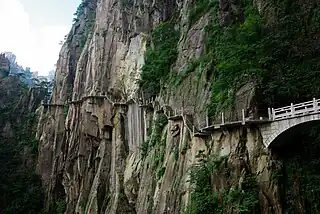 A type of ancient trackway in China | |
| Alternative names | 栈道 |
|---|---|
| Place of origin | China |
The archaeological Gallery Roads (simplified Chinese: 栈道; traditional Chinese: 棧道) were roads through remote mountain areas of China. The roads were constructed using wooden planks that were secured in holes carved into the sides of cliffs. They were often used in the Qin Mountains linking the Wei River and the Han River valleys. The first gallery roads were built during the Warring States period (476–221 BC) and used by Qin to invade Shu and Ba. They were fully consolidated into a thriving network during the Han dynasty. Before the 20th century, very primitive versions were used in the western gorges of the Pamir Mountains.
Introduction

Gallery Roads, also known as Cliff Roads or Plank Roads, represent an engineering achievement in ancient Chinese history. The infrastructure was primarily developed to facilitate transportation across cliffs in steep mountainous regions.[1] The Shu Road is a typical example, it passes through some of China's most rugged and desolate terrains, such as the Qinling and Daba Mountain ranges. The road served as a link between the Wei River valley and the ancient capital of Chang'an, utilizing the plank road technique to secure the pathway to cliffs and steep ravines.[2]
The construction of gallery roads was adapted to the specific topographical features of the surrounding terrain that led to unique structural implementations.[3] The most common gallery road is a wooden plank road that is anchored to the cliffs with holes and wooden piles before being covered with wooden boards. An alternative implementation was stone roads that were carved directly into the cliff faces.[1]
Modern reconstructions incorporate materials such as steel and stone to enhance durability. Some sections have been equipped with glass components to attract tourists.[4]
Historical evidence of Gallery Road
Shudao
Shudao is the general name of the historical road that was constructed through the Qinling, Micang and Daba mountainous barrier. The main function of the Shudao is to connect the Wei River valley (today's Guan Zhong) with the ancient capital Chang’An (today's Xi’An) in the north with Shu (today's Chengdu) in the south.[5] Shu Road passes through the most rugged and desolate terrains in China. The first of the major highways was most likely built in the Warring States (481–221 BCE) period. During the Qin (221–206 BCE) and Han (206 BCE – 220 CE) dynasties, they started massive and advanced road building. For the most part, they took advantage of natural corridors discovered and used by ancient peoples earlier. To build these important paths along the steep and dangerous cliff, the ancients used the innovative road building technique "Gallery Road" to fix the roads on the rock walls and cross the mountains, rivers and valleys.[2]
See also
References
- 1 2 Chen, Hu, Q., Wang, S., & Yang, H. (2016). "A virtual restoration approach for ancient plank road using mechanical analysis with precision 3D data of heritage site". Remote Sensing. 8 (10): 828. Bibcode:2016RemS....8..828C. doi:10.3390/rs8100828.
{{cite journal}}: CS1 maint: multiple names: authors list (link) - 1 2 Jupp, David. "The Application of 3S Technology to Plank Road research and development of spatial information systems in the Qinling and Daba Mountains: I. Geographical, Geological and Historical Background". Shaanxi Peoples Education Press.
- ↑ Li, J (2022). "Ancient Cliff Roads of the Three Gorges". China.org.cn.
- ↑ Global IP News (2021). "State Intellectual Property Office of China Receives Dongguan Hanlin Sensor's Patent Application for Stress Detection Warning Equipment for Glass Gallery Road". Global IP News. Transportation Patent News. p. 1.
- ↑ Wiens, Herold J (1949). "The Shu Tao or the Road to Szechuan: A study of the development and significance of Shensi-Szechuan road communication in West China". PhD Dissertation, Department of Geography, University of Michigan, Ann Arbor, MI.